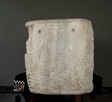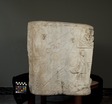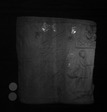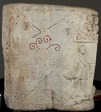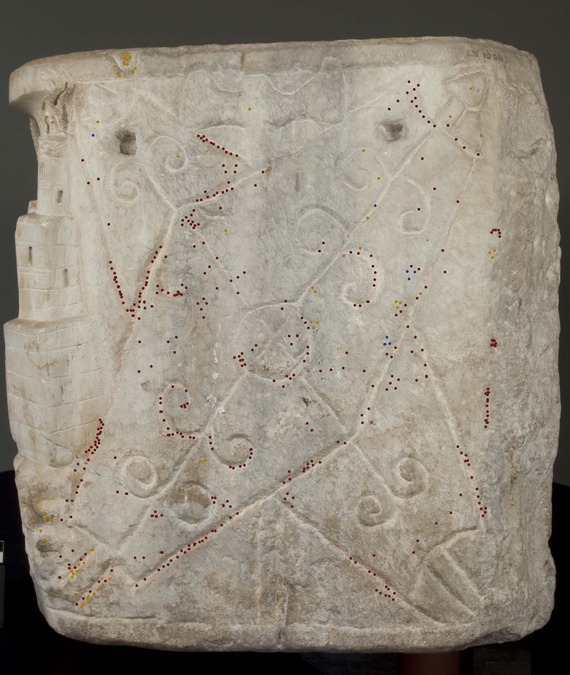Sarcophagus chest; shipping.
Summary
Well preserved sarcophagus chest with a relief representing shipping. Crossed shields on top of crossed spears and a double axe decorate the narrow sides. The chest has remains of antique colour left. Many traces of red are found on the detailing of the ships together with yellow pigments. Visible Induced Luminescence (VIL) imaging reveals extensive remains of Egyptian blue on the waves. Egyptian blue was also used on the narrow sides of the chest in the polychrome rendering of the axes.
Description of object
Three merchant vessels are under sail, two to the right, one to the left. Each ship is manned by crews of three, all naked: an oarsman, and two seamen. At the helm the oarsman controls the two steering oars by means of light extensions attached to the tiller bars. Pennants flown on the ships stream out in a strong wind, and dolphins leap in the heavy seas. On the far right is a lighthouse in three storeys. Buildings on land are seen on the left, made of squared stone and with a terrace on the roof. From it two men observe the ship.
On the narrow sides are roughly incised crossed shields laid over crossed spears and a double axe.
Choice of methods
Visual examination
- Macroscopic
- Microscopic in situ
Technical imaging
- UV
- VIL
Visual examination
The front of the chest has remnants of red colour on all the ships. However, the ship to the right has several areas showing impasto layers of red on the rig, the ropes and the crew. The latter has in most cases red colour in the eyes and occasionally on the skin and hair. Red grains are also observed in the eyes of the dolphins leaping in the sea. The flame of the lighthouse on the right side also carries few red grains and on the relief background very few red and yellow grains are found. A larger amount of yellow colour is found on sails, ropes and hull. On the crew a few, scattered particles of yellow on the face, hair and skin.Architectural elements carry few red and yellow grains. A white yellowish layer is found on the face and body of the servant on the far right side of the chest. A similar white yellowish layer is found on a dolphin. Extensive remains of blue colour is found as both sacttered particles and as distinct layers on the waves and occasionally in combination with seperate particles of yellow or red. Few scattered particles of blue are seen on the faces and bodies of the figures and on the architectural elements.
On the narrow sides the shields show extensive remains of red colour and especially in the incisions compact layers are observed. Yellow particles and occasionally as delicate layers occur on the relief background, the shields, the spears and on the handle of the axe. Minute fragments of what appears to be gold are observed on the shield on top of the axe.
Technical imaging
UV-FL: The chest shows no fluorescence phenomena, but the hull of the ships have yellow brownish areas. VIL: On the waves compact layers reveal a bright, white luminescence. On the central ship and the ship on the right side few, and small particles shine brightly. On the narrow sides both axeheads have areas shining white. However, in one case mostly concentrated in the incisions. A spearhead reveal shining white particles. In all three cases Egyptian blue was probably used to imitate metal.
Bibliography
F. Poulsen (1951), Catalogue of Ancient Sculpture in the Ny Carlsberg Glyptotek, Copenhagen, cat. no. 787.
J.S. Østergaard (1996), Catalogue. Imperial Rome. Ny Carlsberg Glyptotek,, Copenhagen, 77-79, cat. no. 33.
- IN 1299
- Sarcophagus
- Late 3rd century C.E.
- Roman Imperial
- White marble
- Bought from the Villa Borghese in 1895.
- L. 177 cm.; H. 55.5 cm.; W. 52 cm.

